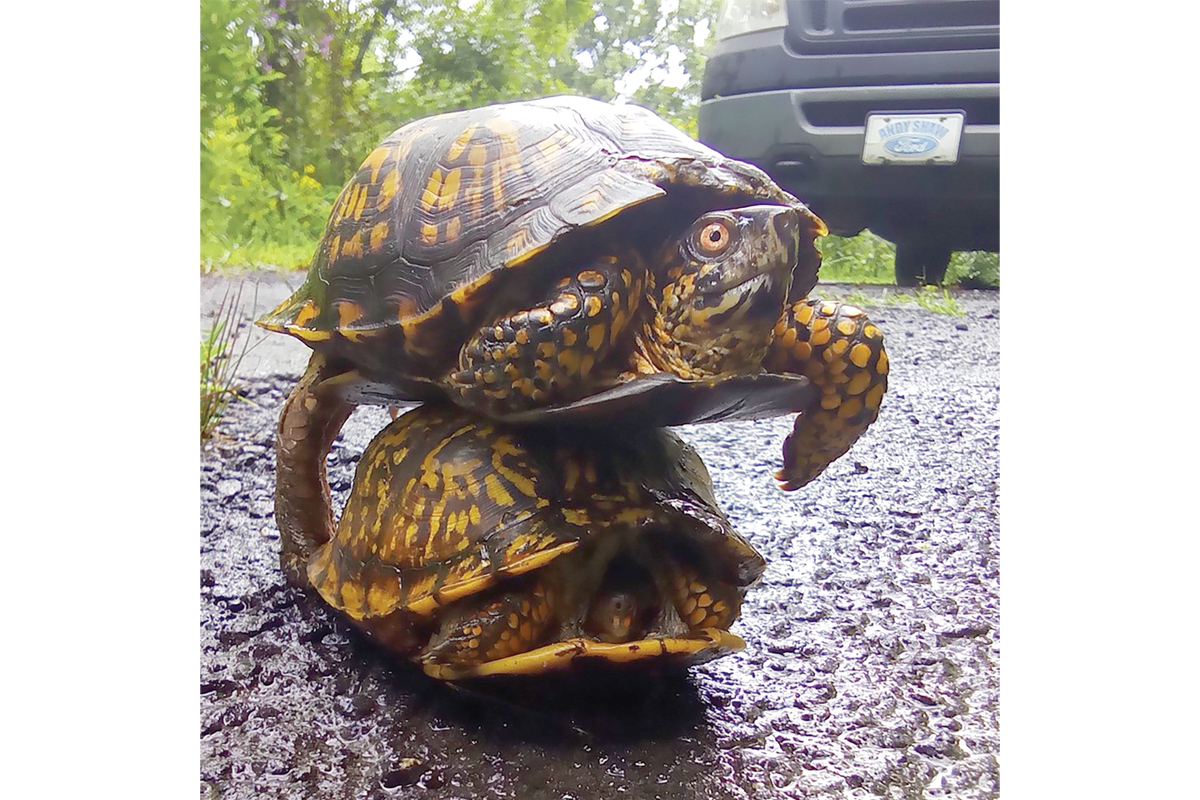Up Moses Creek: ‘It’s a Wild World’
 Jon Ogburn came across these eastern box turtles mating in his driveway. The male’s concave belly shell makes mating easier, but even so it’s a precarious position. Jon Ogburn photo
Jon Ogburn came across these eastern box turtles mating in his driveway. The male’s concave belly shell makes mating easier, but even so it’s a precarious position. Jon Ogburn photo
I hiked up the ridge behind our house early one July morning and saw an eastern box turtle with a millipede in its mouth.
The millipede was one of the big, black and gold “Carolina millipedes” that you occasionally see crawling along in the woods. If you pick it up — scaring it — you get a yellow liquid on your hands that smells like almonds. I’ve been told the liquid is organic cyanide and that millipedes make it to repel predators. But from what I saw on the ridge, the box turtle didn’t mind it.
The turtle was standing in the middle of the trail and it had the millipede by the head. The millipede, around 2 inches long, was sticking straight out from the turtle’s mouth, and it was upside down, its pale belly and two rows of yellow legs turned up to the sky. The turtle froze when it saw me, its four legs planted on the trail. There was something bull-headed about its stance, and for some crazy reason, the sight of it clamped down on that millipede brought to mind a photo I’d seen of Winston Churchill, known to be bull-headed also, with a cigar stuck out of his mouth.
Although the turtle had the millipede by the head, the creature wasn’t dead. Its legs were moving in rhythmic waves, and it kept curling its body towards the turtle. Stick out your index finger and curl it towards you. That’s the movement.
I squatted on my two legs to watch, and the turtle stared back at me on its four. Between us was the millipede with its dozens of legs. When I picked the turtle up, it started pushing against my fingers with its scaly feet and claws, and I thought I heard it say, “Let me go!” The turtle didn’t actually say anything, of course, because its mouth was full of millipede.
To determine its sex, I turned the turtle upside down. Female box turtles have flat belly shells or plastrons; males have plastrons that are concave, making it easier for them to mate. Also, males have reddish eyes, which might indicate their desire to mate, while female eyes are brown. This one was female.
Related Items
When I put the turtle back on the trail, it walked about a foot away and stopped. Then it began to chomp on the millipede’s head, trying to sever it from the body. The turtle chomped and chomped, then finally put out a front foot and pushed against the millipede until it ripped off the body. Having secured a mouthful of head, the turtle began to chew.
I was struck by how methodically it chewed. It made me remember how my mother lectured me at the supper table when I was a boy. I can hear her now: “Burt, chew your food 100 times before swallowing.” Mom was an old-time grammar teacher, and that included the grammar of eating. One hundred chews meant the food would be well masticated. It also meant I’d be eating like an educated human being, not bolting food down “like an animal,” as she put it. And though I’d lose count of the chews, Mom never did. She’d sit at the table looking at me and counting, moving her jaw determinedly up and down to set a proper example. She’d have given that turtle an A.
Then I saw something that Mom would have given an F. Some of the millipede’s legs, detached from its body, were plastered on the side of the turtle’s mouth. The turtle might have chewed 100 times before it swallowed, but they were messy chews.
Early the next morning I hiked up the ridge again. The turtle was gone, but there was the millipede’s headless body on the trail. Either the turtle didn’t like the almond taste of millipede brain and crunchy helmet, or my stares had made it lose its appetite.
I picked the millipede up and saw there was nothing left but the empty shell. Obviously, something liked the taste of millipede—probably ants or yellow jackets. I’ve seen both emerge from millipede shells.
When I got back down to the house, I woke Becky up to tell her what I’d seen, and I heard her mutter from the depths of her pillow, “It’s a wild world out there.”
(Burt and Becky Kornegay live in Jackson County.)









